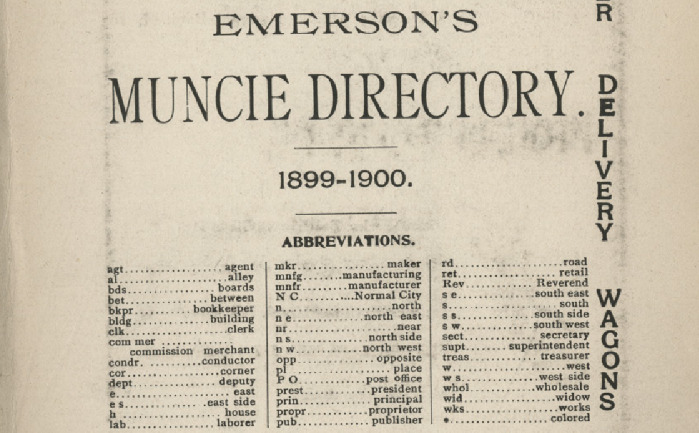Much like other Gilded Age women, Josephine Jones Pierson’s volunteerism began at church. This work offered opportunities for socialization, networking, and cooperative improvement that strengthened the both individuals and their communities. A similar process occurred in Protestant, Catholic, Jewish, Black, White, native-born, migrant, and immigrant communities. Church organizations prepared women for greater public service that extended beyond the local religious group. Learn more about Josephine Jones Pierson’s life and work in the video below.
This video was researched and created by Dylan Meyer, Samuel Steck, Lia Weisbecker-Lotz, and Justin Willis.

1899-1900 Emerson's Muncie directory, 1899.

Detail from 1899-1900 Emerson's Muncie directory abbreviations page, 1899.

1899-1900 Emerson's Muncie directory (Muncie: Charles Emerson & Co., 1899), 533.
City directories provide essential information for historians of local history. Although the earliest American directories date to the mid to late 1700s, Muncie’s earliest printed city directory appeared in 1876. Published by Charles Emerson & Co., the directory was revised every two years in order to reflect current government, business, and residential information.
-
IIn addition to providing names and addresses, directories also encode information about the city and the cultural attitudes of their creators and users. The list of abbreviations (left) from an 1899-1900 directory shows how it reveals urban divisions (like “south side”) and common professions (like “clerk” and “laborer”). The directory also publicized women’s marital status, either by identifying women as “widow” or by listing her as part of her husband’s entry. The city’s racial make-up was also reflected in the text, as the list of abbreviations shows. An asterisk next to a name marked people of color, further segregating them on paper, in addition to the geographic and social segregation they experienced in life. This identification underlines the fact that many Midwestern cities that expected white, native-born Protestants to be the majority group.
-
The bottom image shows the directory page listing Hezekiah Taylor Pierson with his wife, Josephine C, in parentheses. The entry reveals that Hezekiah was a laborer at C.H. Over Windowglass Company. He and his wife lived in a house at 820 E Seymour. As discussed with Dr. Anna Lemon Griffin, newspapers normally identified women with their husbands' names. Josephine would have been Mrs. H. Taylor Pierson. City directories preferred a more detailed style that listed every resident’s first name, normalized marriage, and privileged the married male householder. In this entry we can see the intersection of two identities, both of which minimize Josephine to modern eyes. As a woman, Josephine was categorized publicly under her husband’s name, and as an African-American, she was set apart with an asterisk.
-
Although this marginalization is lamentable, these records are important, as they allow historians better understand the experience of people of color in small towns. In many towns and cities the contributions of people of color in this period are still understudied and not widely known. Paradoxically, by identifying Black residents, the city directory has made it easier to investigate their presence and impact on the community. Although Muncie’s Black population was only about 6% of the overall population in 1900, Black people in Muncie made significant economic and cultural contributions to Muncie.
-
In spite of racial segregation, Josephine Jones Pierson, along with many other Black women, cultivated civic lives and spaces in Muncie. Their energy and successes provided social and spiritual activities, as well as education and entertainment for women.
To hear more about the historian's process and the methodologies used to research and create historical narratives, check out the discussion with Meyer, Steck, Weisbecker-Lotz, and Willis below.
Josephine Jones Pierson was an active and social woman, who played an important role in Muncie's growing African American community. Click "Conclusion" below to see how all of these women's lives, though different, work together to form a microcosm of Muncie society.



